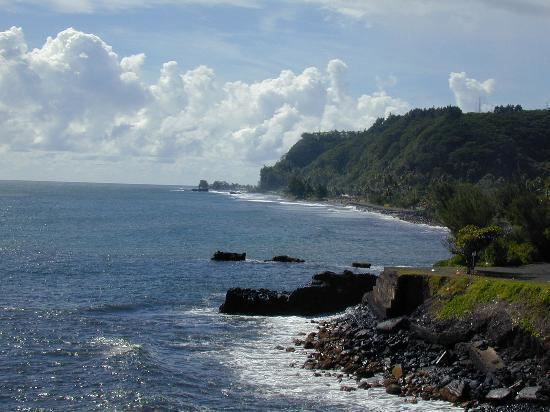Country France Area 299.5 km2 | ||
 | ||
Points of interest Robert Wan Pearl Museum, Notre Dame Cathedral - Papeete, Papeete Tahiti Temple | ||
Map of Papeete
Papeete (pronounced [pa.pe.ʔe.te]) is the capital of French Polynesia, an overseas country of France in the Pacific Ocean. The commune (municipality) of Papeete is located on the island of Tahiti, in the administrative subdivision of the Windward Islands, of which Papeete is the administrative capital. The French High Commissioner also resides in Papeete. It is the primary center of Tahitian and French Polynesian public and private governmental, commercial, industrial and financial services, the hub of French Polynesian tourism and a commonly used port of call. The Windward Islands are themselves part of the Society Islands. The name Papeete means "water from a basket".
Contents
- Map of Papeete
- Papeete tahiti french polynesia downtown papeete hd 2017
- Geography
- History
- Transportation
- Demographics
- Historical population
- Migrations
- Languages
- Travel and tourism
- Climate
- Main sights
- In popular culture
- Economy
- Education
- References
The urban area of Papeete had a total population of 133,627 inhabitants at the August 2012 census, 25,769 of whom lived in the commune of Papeete proper.
Papeete tahiti french polynesia downtown papeete hd 2017
Geography
The commune of Papeete is subdivided into eleven quartiers (wards):
History
At the outbreak of World War I Papeete was shelled by German vessels, causing loss of life and significant damage.
The growth of the city was boosted by the decision to move the nuclear weapon test range from Algeria to the atolls of Mururoa and Fangataufa, some 1,500 km (930 mi) to the east of Tahiti; this originated in particular in the construction of the Faa'a airport next to Pape'ete, the only international airport in French Polynesia. In 1983, The Church of Jesus Christ of Latter-day Saints built the Papeete Tahiti Temple here because of the large number of members in the region. On 5 September 1995 the government of Jacques Chirac conducted the first of the last series of nuclear test detonations off the shores of Moruroa. A resulting riot in Papeete lasted for two days and damaged the international airport, injured 40 people, and scared away tourism for some time. (Similar rioting occurred after another French nuclear test in the same area in 1987.)
Transportation
There are very busy streets in the town center, and sometimes traffic can be a problem since the streets are very small. There is a freeway that starts close to the town center starting with Pomare Boulevard, named after the Tahitian Royal Family dynasty of the 19th century. By air, the people would use the Faaa International Airport. From there they could either take Air Tahiti to go to another island of the territory or take a plane like Air Tahiti Nui to go international. By sea, they would either take Moorea ferries to go to Moorea or the Bora Bora cruiseline to go to Bora Bora.
Demographics
The urban area of Papeete has a total population of 133,627 inhabitants at the August 2012 census, 25,769 of whom lived in the commune of Papeete proper. The urban area of Papeete is made up of seven communes. They are listed from northeast to southwest:
Historical population
Average population growth of the Papeete urban area:
Migrations
The places of birth of the 131,695 residents in the Papeete urban area at the 2007 census were the following:
Languages
At the 2007 census, 98.2% of the population in the urban area of Papeete whose age was 15 years and older reported that they could speak French. 96.5% reported that they could also read and write it. Only 1.2% of the population whose age was 15 years and older had no knowledge of French.
At the same census, 79.7% of the population in the urban area of Papeete whose age was 15 years and older reported that the language they spoke the most at home was French. 16.5% reported that Tahitian was the language they spoke the most at home. 1.7% reported another Polynesian language, 1.6% reported a Chinese dialect (half of whom speak Hakka), and 0.5% reported another language.
19.5% of the population in the urban area of Papeete whose age was 15 years and older reported that they had no knowledge of any Polynesian language at the 2007 census, whereas 80.5% reported that they had some form of knowledge of at least one Polynesian language.
Travel and tourism
Traveling tourists arrive and depart Papeete via cruise ship at Papeete Harbor or domestic airline at Faa'a International Airport, which was completed and opened in 1962.
Climate
Papeete features a tropical monsoon climate with a wet season and dry season. However, precipitation is observed even during the city's dry season. The dry season is short, covering only the months of August and September. The rest of the year is wet, with the heaviest precipitation falling in the months of December and January. Temperatures are relatively constant throughout the course of the year, averaging around 25 °C (77 °F).
Main sights
In popular culture
Economy
Air Tahiti Nui has its head office in the Immeuble Dexter in Papeete.
Education
The Lycée Paul-Gauguin is located in the city.
